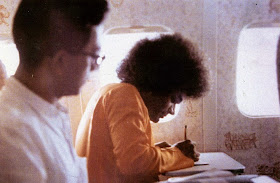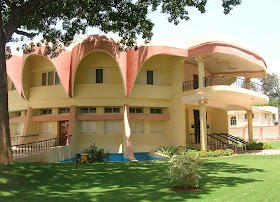.jpg) |
| Swami in the Prasanthi Nilayam portico |
13th July 2000
During the evening Darshan,
Swami : Where do you come from?
Student : Swami from You. (Swami smiled at him. Students belonging to the institute music group showed a card to Swami asking permission for music program on Guru Pournima day.)
Swami : Koorcho…Koorcho. ( Sit…sit )
Later, Swami went near the birthday boys and autographed five to six photos. Then he came to Ganesh Portico,
Swami : (to students) What did he (Anil Kumar sir) talk in the morning? Bhaja Govindam or Shankaracharya? (to Anil Kumar sir) How many Shlokas did Shankara compose?
Prof. A. K. : Swami he composed 12 and his disciples composed 14.
Swami : How do you know?
Prof. A. K. : Swami, from books on ‘Adi Shankara’.
 |
| Sri Adi Shankaracharya and his disciples |
Swami : No. He composed only one Shloka - Samprapte San Neehite Kale… Nahi Nahi Rakshati Dukrun Karane (Meaning – When the end comes, your grammar will not protect you.) Shankara got five Jyotir Lingas and installed four of them and one is missing.
Prof. A. K. : Where is it Swami.?
Swami : (smilingly) It is Chidambara Rahasyam. He placed it at the feet of Nataraja. Where are the four Peethams?
Prof. A. K. : Swami, Dwaraka, Shringeri, Puri and Badrinath.
 |
| The Four Maths established by Sri Adi Shankaracharya |
Swami : Who were the disciples in-charge of these Peethams? (Anil Kumar sir tried to answer. But could not relate the disciples with their respective Peethams correctly.) Don’t guess. Shankaracharya propagated Advaita (Non-dualism), Madhvacharya - Dvaita (Dualism) and Ramanuja - Vishishta Advaita (Qualified Non-dualism). But through Advaita, one cannot enjoy the sweetness of God. Like sugar which cannot enjoy its own sweetness. Through Vishishta Advaita, you can enjoy the sweetness of God. You can reach Advaitic state through Vishista Advaita. Once in an argument, in favour of Advaita, he defeated his opponent, Mandana Mishra. Mandala Mishra’s wife, Ubhaya Bharati, put forth a question on Kama-Tatwa (experience of a householder). But Shankara could not explain because he has not experienced it. Therefore, he did Parakaya Pravesham (entering another body). He entered a dead king’s body, experienced it, and explained it to her. That time in a temple in Kashmir, the doors of the temple closed. Ubhaya Bharati told him, “You talk about Advaita. But, you have the feeling that you are different from that person and you have to experience through him and explain. It is Dvaita (dualism)”.
He agreed to his mistake and the doors of the temple opened. After realising his mistake, Shankara made a pyre (fire) and jumped into it. But Varuna Devata (God of the water bodies) took mercy on him and it rained. Only his legs got burnt. Who are his important disciples?
 |
| Sri Ramanujacharya: The Propounder of Vishishta Advaita Philosophy |
Prof. A. K. : Few of them are there Swami.
 |
Padmapada - Running across the river at
his Guru's command |
Swami : No. Padmapada was the important disciple. He gained wisdom by Guru Seva. It is said – ‘Guru Brahma, Guru Vishnu, Guru Devo Maheshwara. Guru Shakshat Para Brahma.’ (Guru is Brahma, Vishnu, and Maheshwara. Guru is verily the embodiment of Brahman) Once while he was washing clothes in the river, there was a sudden flood. To protect his Guru’s clothes, he started running. Wherever his foot touched the surface of the water, there appeared a lotus under his foot. Hence, he was called Padmapada (Lotus Feet). Advaita is Jnana Kanda and Dvaita is Karma Kanda. In between them is Vishishta Advaita. To get Jnana (wisdom) through Bhakti (devotion) is Vishishta Advaita.
 |
| Sri Madhvacharya: The Propounder of the Dvaita Philosophy |
Prof. A. K. : Swami, Paramatma is Nityam (permanent) and Prakruti (creation) is Anityam (Non-permanent) .
Swami : No. Prakruti is also Nityam. But Prakruti Vastu (created objects) are Anitya (non-permanent). It is like this - Individual cows may die. But not the cow clan; People may die, but not Manava Jaati (humanity); Society always remains, even though people in the society die. Prakruti is permanent. It is only through Prakruti that one can attain Paramatma (Divinity). You cannot ask which is important. Mother and father, both are important for a son. Similarly, both Prakruti and Paramatma are important.
Prof. A. K. : Swami, if both Prakruti and Paramatma are important, where is Ekatwam (oneness)?
 |
| Sri Sathya Sai: There is only one - Unity in Diversity |
Swami : Ekatwam is there in Nityatwam (permanence). Bhinnatwam (Separateness) is Anityam. Ekatwam is Nityam. The word ‘Bhinna’ itself means Veru - separate.
Teacher : In Trayee Brindavan, Swami has told that Bhinnatwam and Ekatwam are two sides of the same coin.
Swami : Yes, they form the two sides of the same (more stress) coin.
Teacher : Swami, Unity in Diversity.
Swami : Yes. Ekatwam people do not go for argument. Only Bhinnatwam people go for argument. Parameshti, Samashti, Vyashti and Srushti. Divinity (Parameshti) in community (Samashti) operates through individuals (Vyashti) for creation (Srushti).
(From a distance, a schoolboy showed a card to Swami. Swami signalled him to come close. On the card, it was written - ‘Swami, I want to merge in You.’)
(To institute students) Boys don’t know exactly the meaning of some words. They learn some words and write them, but they don’t know the meaning.
(Swami opened the above-mentioned letter and showed it.) See, what the boy has written, “I Want To Merge In You.” What is the meaning of ‘merge’? Rivers merge in the ocean and they lose their identity and be one with the ocean. It should be like this. It is true merging. Before merging, they have different names, different taste different forms, and ones they merge, they lose their identity completely. It is not easy.
Student : How is it Swami?
Swami : It is not by practice that you go near God and then merge with Him. It is Upanishad. Upanishad is coming near. The four steps to come near are Salokyam, Sarupyam, Sameepyam, Sayujyam. First remember the name (Salokyam), and then comes the form (Sarupyam), slowly you come near (Sameepyam) and finally merge (Sayujyam).
(To another student) Do you want to merge?
Student : Yes Swami.
Swami : (To another student, punning the words Majjiga and merge) Ask Siva Sankara Sai (Warden) to give him one glass of Majjiga (buttermilk). Majjiga Le Sakta Hai. Merge Kaise Ho Sakta Hai? (You can have buttermilk. But how can you merge!)
Near the interview room door, the music group students again showed their card, asking permission for the music program on the Guru Pournima day.
Swami : (seeing the card) Enduku Ra Idi? (What for is this? )
Students : Guru Pournima Programme Swami.
Swami : (showed a letter written by the above mentioned student) See, somebody has written - ‘I want to merge’, without knowing, what merging is?. What is the meaning of merging? (No answer) Take river. River goes and merges in ocean. Before merging, river was there. After merging there is no name and form for the river. There is only ocean. Saalokyam, Saaroopyam, Saameepyam and Saayujyam. River goes to ocean for merging. But ocean will not easily allow it to merge. It will say, “Go away, go away.” for 2-3 days. That is backwater. The river will say, “No. I want to merge. I want to merge.” Finally the ocean will say, “Come in”. That time, the ocean will rise up and the river will go underneath. If you see the place where the river merges, you can see the ocean water on the top and the river water below. Sameepyam is going nearer. (Swami saw their card and went through the songs written on it.) Only ten songs. Swami read out the song - “Every moment of my life…”
(To Registrar) How is the Vice-Chancellor’s health?
Registrar : Now, he is fine, Swami.
Swami : For diabetics, the best medicine is diet control. No other medicine is required.
(To music group students) Which class are you studying? (They replied that they are from MBA, MFM and M.Sc.) All are in MBA or M.Sc. No MRS. (To a guest) what is MRS? (No reply.) Mrs.!! (Laughter. To another student) Which class?
Student : Swami M.Tech.
Swami : M.Tech or M. Trick?
Teacher : If Swami gives permission, we like to have some solo performance.
Swami : Whatever you asked, do that. If you have more programs, do according to the time available.











.tif)














.jpg)





